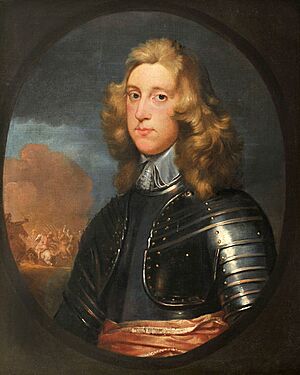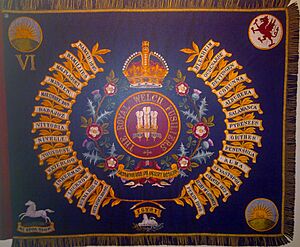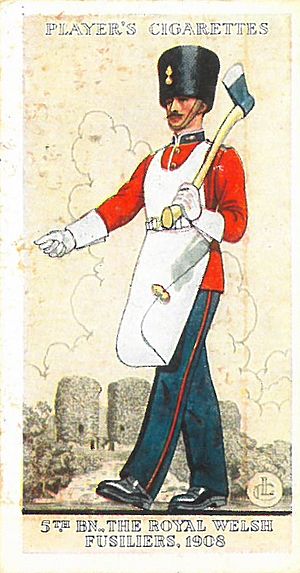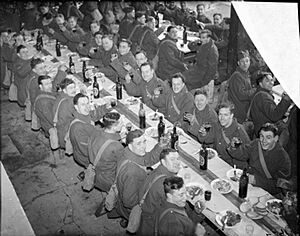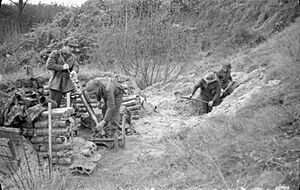Royal Welch Fusiliers facts for kids
Quick facts for kids 23rd Regiment of FootWelch Regiment of Fusiliers Royal Welch Regiment of Fusiliers Royal Welch Fusiliers |
|
|---|---|
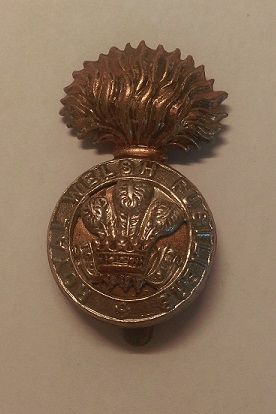
Cap badge
|
|
| Active | 16 March 1689 – 28 February 2006 |
| Country | |
| Branch | |
| Type | Infantry |
| Role | Line infantry |
| Size | 1–2 Regular battalions 4–12 Volunteer and Territorial battalions |
| Garrison/HQ | Hightown Barracks, Wrexham |
| Nickname(s) | The Nanny Goats The Royal Goats |
| Motto(s) | Ich Dien |
| Anniversaries | St. David's Day (1 March) |
| Engagements | Williamite War in Ireland Nine Years' War War of the Spanish Succession War of the Austrian Succession Seven Years' War American War of Independence French Revolutionary Wars Napoleonic Wars Crimean War Second China War Indian Mutiny Third Anglo-Burmese War Second Boer War First World War Second World War The Troubles Yugoslav Wars |
| Commanders | |
| Ceremonial chief | The King |
| Colonel of the Regiment |
Major-General Brian Plummer |
| Insignia | |
| Tactical Recognition Flash | 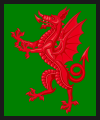 |
| Hackle | White |
The Royal Welch Fusiliers (Welsh: Ffiwsilwyr Brenhinol Cymreig) was a famous infantry regiment of the British Army. It was formed in 1689, right after a big change in England called the Glorious Revolution. This regiment was part of the Prince of Wales' Division.
In 1702, it became a "fusilier" regiment. This meant its soldiers used lighter guns called 'fusils' to protect the army's cannons. It was then called the Welch Regiment of Fusiliers. The word "Royal" was added in 1713. In 1714, King George I officially named it the Prince of Wales's Own Royal Regiment of Welsh Fusiliers.
Later, in 1751, the way regiments were named changed. It became the 23rd Regiment of Foot (Royal Welsh Fuzileers). In 1881, it got its final name, the Royal Welch Fusiliers. The regiment kept the old spelling of Welch instead of Welsh. It also used Fuzileers for Fusiliers for a long time.
The Royal Welch Fusiliers was one of the few regiments to keep its original name for so long. But in March 2006, it joined with another regiment, the Royal Regiment of Wales. Together, they formed a new, larger regiment called the Royal Welsh.
Contents
The Royal Welch Fusiliers: A Brief History
The Royal Welch Fusiliers had a long and exciting history. They fought in many important wars and battles for Britain.
How the Regiment Started (1689-1773)
The regiment was created by Henry Herbert on March 16, 1689. This happened in a town called Ludlow. Their first big task was fighting in the Williamite War in Ireland from 1689 to 1691. They were at the Battle of the Boyne in 1690 and the Battle of Aughrim in 1691.
After that, they joined other allied forces in the Nine Years' War. In August 1695, they helped attack a fort at Namur. This attack even inspired a famous song called 'The British Grenadiers'.
When the War of the Spanish Succession began in 1702, the regiment became the Welch Regiment of Fuzilieers. They fought in many battles with Marlborough, including Schellenberg, Blenheim, and Ramillies.
In 1714, King George I gave them a special title: the Prince of Wales's Own Royal Regiment of Welsh Fusiliers. For the next 28 years, they mostly guarded places in England and Scotland.
They returned to Europe in 1742 for the War of the Austrian Succession. At Dettingen in June 1743, they showed great bravery. They were pushed back by French cavalry but managed to regroup. This helped them win the battle. In May 1745, they had many soldiers injured at Fontenoy. After that, they briefly went to Scotland to help with the 1745 Rising.
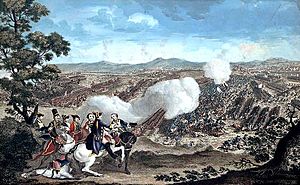
In 1751, the regiment was officially named the 23rd Regiment of Foot (Royal Welsh Fuzileers). They were part of the Minorca garrison that surrendered to the French in 1756. From 1758, they fought in Germany during the Seven Years' War. At the Minden in August 1759, they helped defeat the French cavalry. This achievement is still celebrated as Minden Day by their modern-day successors, the Royal Welsh.
They also fought in battles like Warburg (1760) and Wilhelmsthal (1762). The war ended with the Treaty of Paris in 1763.
When the American Revolutionary War started in 1773, the regiment went to North America. They lost many soldiers at the Battle of Bunker Hill in June 1775. They fought in almost every major campaign until the Siege of Yorktown in September 1781. At Yorktown, they were the only British regiment that did not surrender its flags. A young officer secretly took them out.
In the early French Revolutionary Wars, they went to the West Indies in 1794. They helped capture Port-au-Prince in 1795. Then they returned home in 1796. In 1799, they fought in the Anglo-Russian invasion of Holland at Alkmaar.
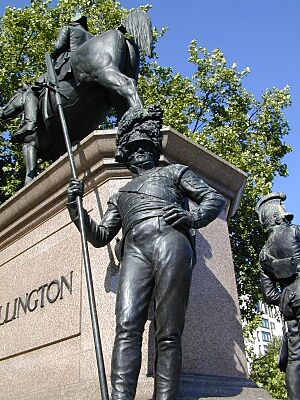
The 19th Century: More Battles and Changes
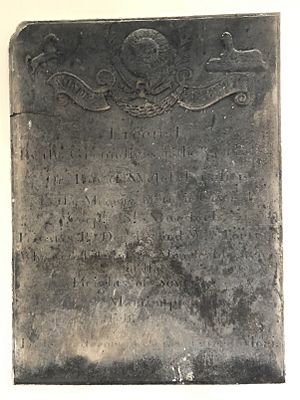
During the Napoleonic Wars, the regiment fought in Egypt at the Battle of Alexandria in 1801. They also took part in the Invasion of Martinique in 1809. From 1810, they were sent to the Peninsular War in Spain and Portugal. Between 1811 and 1814, they fought in many battles with Wellington. These included Albuera, Badajoz, Salamanca, Nivelle, and Toulouse. They were also at the famous Battle of Waterloo in June 1815.
In the 1800s, the regiment also fought in the Crimean War, the Second Opium War, the Indian Mutiny, and the Third Anglo-Burmese War.
Changes were made to the British Army in the late 1800s. The regiment officially became The Royal Welsh Fusiliers on July 1, 1881. The old spelling "Welch" was used again officially in 1920.
The 1st battalion fought in the Second Boer War from 1899 to 1902. The 2nd battalion was in Hong Kong and then India. The 2nd battalion also served in China during the Boxer Rebellion in 1900. They even fought alongside the United States Marine Corps.
The 20th Century: World Wars and Beyond
Before the First World War, the army made more changes. The regiment had several battalions (groups of soldiers). These included the 3rd (Reserve) Battalion and four Territorial Force (TF) battalions: the 4th (Denbighshire), 5th (Flintshire), 6th (Carnarvonshire & Anglesey), and 7th (Merionethshire and Montgomeryshire) Battalions.
The First World War (1914-1918)
The 1st and 2nd battalions fought on the Western Front in France from 1914 to 1918. They were in some of the toughest battles, like Mametz Wood in 1916 and Passchendaele in 1917. Some famous writers, like Robert Graves and Siegfried Sassoon, served with the 1st Battalion and wrote about their experiences.
Many other battalions were formed for the war, often called 'Kitchener' or 'Pals' battalions. The 4th (Denbighshire) Battalion was one of the first TF units to fight in France. Other Royal Welch battalions also fought on the Western Front at battles like Loos and the Somme.
The 5th, 6th, and 7th Territorial battalions fought in the Gallipoli Campaign. They then moved to the Middle East, taking part in the Sinai and Palestine Campaign.
Between the World Wars
After the First World War, the Territorial Force became the Territorial Army (TA). In 1938, the 5th (Flintshire) Battalion changed to become an anti-tank artillery unit. Just before World War II, the Territorial Army grew, and new battalions were created.
The Second World War (1939-1945)
The regiment earned 27 battle honours for its actions in World War II. More than 1,200 of its soldiers died.
The 1st Battalion fought in France and Belgium in 1940 with the British Expeditionary Force. They had to retreat and be rescued during the Dunkirk evacuation. After two years in the UK, they were sent to British India. There, they fought the Imperial Japanese Army in the Burma Campaign. They were key in the Battle of Kohima, which was a very fierce battle that helped turn the war around in that area.
The 2nd Battalion fought in the Battle of Madagascar in 1942. Later, they also went to the South-East Asian Theatre. Both battalions were under the command of Lieutenant-General Bill Slim. His army was sometimes called the 'Forgotten Fourteenth' because their fighting seemed less noticed.

Territorial and War Service Battalions in WWII
The 4th, 6th, and 7th Territorial battalions fought in the Battle of Normandy. They were at Hill 112, where they suffered many casualties. They also fought bravely in Operation Veritable, a very tough battle in Germany.
The 10th battalion was changed into the 6th (Royal Welch) Battalion of the Parachute Regiment. This parachute battalion took part in the Allied invasion of Italy and Operation Dragoon, the invasion of Southern France. Later, they were sent to Greece to help during the Greek Civil War.
After the Second World War
The 2nd Battalion stayed overseas after World War II, helping to keep peace in Burma. They also served several times in Northern Ireland (Operation Banner).
During the Yugoslav Wars in 1995, the regiment was involved in a difficult situation. 33 of their soldiers, along with other UN troops, were taken hostage by Bosnian Serbs in Goražde. The UN troops were there to protect the town but did not have enough power to fight back fully. The Royal Welch Fusiliers held off the Bosnian Serbs until they had to take cover. Their commanding officer, Lt Col Jonathon Riley, even called the Prime Minister John Major directly from his bunker. All the soldiers were eventually rescued. The regiment received many awards for their bravery. Observers later said the regiment helped save the town from a terrible event.
Joining Forces
The Royal Welch Fusiliers was one of only five infantry regiments that had never joined with another regiment in its entire history. However, in 2004, it was announced that they would merge with the Royal Regiment of Wales. This new, larger regiment is called the Royal Welsh.
To honor their strong connection, the United States Marine Corps gave a set of their flags to the regiment in Wrexham in 1945. The regiment also has a special chapel inside St Giles Parish Church in Wrexham, where their flags and other important items are kept.
Regimental Museum
You can learn more about the Royal Welch Fusiliers at their museum. The Royal Welch Fusiliers Museum is located in Caernarfon, Wales.
Battle Honours
The regiment was given many special "battle honours" to remember their bravery in different wars and battles. Here are some of them:
- Namur 1695, Blenheim, Ramillies, Oudenarde, Malplaquet, Dettingen, Minden, Egypt
- Peninsular War: Corunna, Martinique 1809, Albuhera, Badajoz, Salamanca, Vittoria, Pyrenees, Nivelle, Orthes, Toulouse, Peninsula
- Napoleonic War: Waterloo
- Crimean War: Alma, Inkerman, Sevastopol
- Lucknow, Ashantee 1873–1874, Burma 1885–1887, Relief of Ladysmith, South Africa 1899–1902, Pekin 1900
- First World War: Mons, Le Cateau, Retreat from Mons, Marne 1914, Aisne 1914 '18, La Bassée 1914, Messines 1914 '17 '18, Armentières 1914, Ypres 1914 '17 '18, Langemarck 1914 '17, Gheluvelt, Givenchy 1914, Neuve Chapelle, Aubers, Festubert 1915, Loos, Somme 1916 '18, Albert 1916 '18, Bazentin, Delville Wood, Pozières, Guillemont, Flers-Courcelette, Morval, Le Transloy, Ancre Heights, Ancre 1916 '18, Arras 1917, Scarpe 1917, Arleux, Bullecourt, Pilckem, Menin Road, Polygon Wood, Broodseinde, Poelcappelle, Passchendaele, Cambrai 1917 '18, St. Quentin, Bapaume 1918, Lys, Bailleul, Kemmel, Scherpenberg, Hindenburg Line, Havrincourt, Épéhy, St. Quentin Canal, Beaurevoir, Selle, Valenciennes, Sambre, France and Flanders 1914–1918, Piave, Vittorio Veneto, Italy 1917–1918, Doiran 1917 '18, Macedonia 1915–1918, Suvla, Sari Bair, Landing at Suvla, Scimitar Hill, Gallipoli 1915–1916, Rumani, Egypt 1915–1917, Gaza, El Mughar, Jerusalem, Jericho, Tell 'Asur, Megiddo, Nablus, Palestine 1917–1918, Tigris 1916, Kut al Amara 1917, Baghdad, Mesopotamia 1916–1918
- Second World War: Dyle, Defence of Escaut, St. Omer-La Bassée, Caen, Esquay, Falaise, Nederrijn, Lower Maas, Venlo Pocket, Ourthe, Rhineland, Reichswald, Goch, Weeze, Rhine, Ibbenburen, Aller, North-West Europe 1940 '44–45, Madagascar, Middle East 1942, Donbaik, North Arakan, Kohima, Mandalay, Ava, Burma 1943–1945
Victoria Cross Heroes
The Victoria Cross is the highest award for bravery in the British military. These members of the regiment received it:
- Captain Edward William Derrington Bell, Crimean War (1854)
- Lieutenant Thomas Bernard Hackett, Indian Rebellion of 1857 (1857)
- Company Sergeant Major Frederick Barter, First World War (1915)
- Corporal John Collins, First World War (1917)
- Corporal James Llewellyn Davies, First World War (1917)
- Corporal Joseph John Davies, First World War (1916)
- Lt-Colonel Charles Doughty-Wylie, First World War (1915)
- Private Albert Hill, First World War (1916)
- Colour-Sergeant Luke O'Connor, Crimean War (1854)
- Lance-Sergeant William Herbert Waring, First World War (1918)
- Lance-Corporal Henry Weale, First World War (1918)
Royal Leaders of the Regiment
These members of the Royal Family were special leaders for the regiment:
- 1901: King George V
- 1936: King George VI
- 1953: Queen Elizabeth II
Regimental Mascot: The Nanny Goat
Like the Royal Regiment of Wales, the Royal Welch Fusiliers had a special goat. This goat was never called a "mascot" but was a very important part of the regiment. This tradition started a very long time ago, possibly as early as when the regiment was formed. The goat was always named 'Billy'.
Unique Uniform Features
Soldiers of this regiment had a unique part of their uniform called the "flash." This was made of five black silk ribbons that overlapped. It was worn on the back of their uniform jacket, near the neck. This tradition came from a time when soldiers used to wear their hair in pigtails.
In 1808, pigtails were no longer worn, but the Royal Welch Fusiliers were overseas and didn't get the message. So, they kept wearing the ribbons. In 1834, King William IV allowed them to keep this special "flash" on their dress uniform. It became a way to show how special the regiment was.
When khaki uniforms became common, the army tried to remove the flash during the First World War. They said it would help the Germans identify the unit. But the regiment argued that no enemy had ever seen the back of a Royal Welch Fusilier in retreat! So, they kept the flash. King George V even told an officer, "don't ever let anyone take it from you!"
As a "fusilier" regiment, the Royal Welch Fusiliers also wore a "hackle." This was a plume of white feathers placed behind the cap-badge on their beret. For special occasions, their full dress uniform included a racoon-skin hat (or bearskin for officers) with a white hackle and a red tunic with dark blue details. This uniform was worn by the regiment's drummers and pioneers until the merger in 2006.
Images for kids
-
The grave of Welsh poet Hedd Wyn, killed at Passchendaele in 1917


